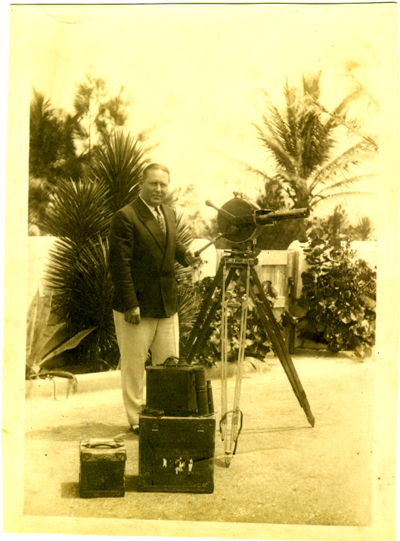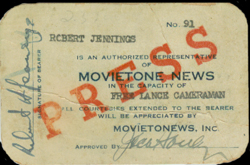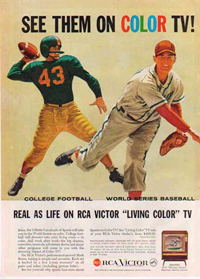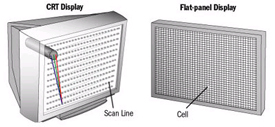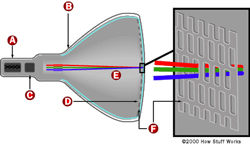|
Early Color Television
My great-uncle was the poster boy for Buster Brown Shoes (circa 1904), his later growing up to find a career as a film photographer for Movietone News . Later, he was credited with among other things the filming of the crash of the Hindenburg. As he evolved professionally in his trade, he made a move into the new black & white television broadcast industry finding his way as a freelance cameraman, creating a film on the icon news anchorman, Gabriel Heatter. I met this amazing man when I was a teenager in the late 1950's, visiting him in his home for part of a summer in Brookfield Center, Connecticut. At the time he had recently retired, servicing and selling color televisions, believing this new medium was the future of instant communications for Americans. He was right. Some of his customers were the early television stars themselves, commuting to their high-level jobs in New York City traveling from their private homes located in upper Westchester County, New York, and western Connecticut, buying new televisions from my uncle who they had known in the industry. Gabriel Heatter, the noted early American newscaster, lived about a mile down the road from Jennings and became close friends. Jennings also served as a freelance cameraman for creating a film on Heatter, using Heatter's own studio located in a barn on his property. Jennings entertained prospective buyers in his home's innovative storefront, playing the Hammond Organ as they shopped on his sales floor, a musical talent he had mastered early in his life playing for the silent movies in nearby Brewster.
Color television in the late 1950's was brand new to the industry, NTSC standards just being established. One proposal, for example, had suggested the use of a high-speed rotating color wheel located within the studio camera. Its rotation would then be matched in speed by an exact duplicate wheel rotating in the customer's home television set. While this system was ultimately not selected, unbelievably the rotating color wheel concept has found its way back into today's new HDTV technology, this time in an extremely sophisticated viewing format as part of the emerging DLP technology of today's high-end wide-screen television products.
However, the National Television Systems Committee (NTSC) set the broadcast television standard, an innovative method that transmited colors as waveforms representing red, green, and blue, their final destination in the form of an electron beam inside the cathode ray tube (CRT) that is controlled by embedded horizontal and vertical signals responsible for creating the scan rates that assemble the final color picture onto the screen (see chart below from "How Stuff Works.") There is also an optional color signal embedded in the signal to flag the television circuit that a color signal is incoming. However, if the receiving TV set is only capable of b&w pictures, the color signal is then ignored with the picture tube still able to faithfully reproduce the original color picture into black and white. And that was the beauty of the NTSC system.
Strong vertical and horizontal magnetic fields are created around magnets that are slipped onto the yoke of the picture tube. These magnets direct the beams of the electrons and guides them to hit the correct red, green, and blue phosphors dots that are screened onto the inner surface of the glass picture tube. This allows the faithful reproduction on the home television screen of exactly what is being seen by the broadcast studio camera's electron pickup tube live (or recorded to tape) from its location anywhere in the world.
Unlike nature's reflective primary colors made up of red, yellow, and blue, electronically transmitted primary light colors are instead red, green, and blue, red and green making yellow. Reflective color is when daylight hits, let's say, a green leaf. Your eye sees the green because all the other colors are being absorbed. When the chemical composition of the leaf changes in the fall and its photosynthesis has stopped, basically all colors are eventually reflected off the surface of the leaf evolving from yellows and reds to finally brown. With refective colors. white and black are shown as the absence of color. But for your standard direct-view television set using transmitted colors, white is actually achieved on the surface of the CRT screen by the mixing of tiny dots of red, green, and blue colors in a mathematical relationship the human eye conceives as white. "Pure" black is produced by the CRT when the electron beam is shut off from hitting any color dots at all, no phosphorus then being illuminated as if the tube was turned off. If you were to place a magnifying glass over the surface of your picture tube when it's showing only white on the screen, you would not see white at all but dots in the three different transmitted colors of red, green, and blue. If you happen to see instead tiny rectangles of color, your picture tube is using the more popular in-line cathode ray tube (CRT) technology as shown above, which dramatically helps to achieve greater contrast that provides a more realistic picture. When Jennings was shipped his supply of early color television consoles for display on his sales floor, the picture tube and magnetic yokes arrived separately from the rest of the set, the CRT needing to be installed and the tube converged before the set could be sold. If the set was not converged, you would only see a rainbow of colors covering the screen while hearing the sounds of the program. Manufacturers had been concerned that the delicate CRT, thinking it could be better protected from damage being shipped in a separate carton, and not wanting it to accidently explode within a television set's cabinet on its way to the dealer, the inside of the tube having formed a vacuum.. However, in this configuration the installation and convergence cost could also be passed onto the dealer. Of course, if the manufacturer was to move product in large volumes, it would eventually have to ship sets ready to view right out of the box. And that is what happened. As CRT manufacturing improved, there was no longer a need to ship the tube separately, the CRT now installed by technicians at the factory along with its three-gun convergence already set up, the set leaving the factory ready to view. Now the dealer could open the box, remove the television console, connect the back of the set to a 300-ohm antenna cable from a roof-mounted VHF/UHF antenna, and plug it in to a wall outlet for immediate demonstration on the sales floor. Television sales people no longer needed to be technicians. But of course, in the days of vacuum tubes it helped knowing which tube to replace if the picture went out.. By the way, a vacuum tube in Britain is called a Value, which really describes how it functions, controlling the flow of electrons much like a facet controls the flow of water. As with today's HDTV signals, early color television had very few broadcast
channels dedicated to the new color medium, channels normally broadcast
only in black and white. Color sets in the late 1950's cost over $800
each and were sold in a more modern and attractive all-wood styled cabinet,
the controls placed to the side of the picture tube allowing the cabinet
to be lower to the floor and wider. Black and white sets are still sold today, but instead in small chassis used as portable units with screen sizes of around 5-inch or less diagonal with built-in VHF/UHF tuners that are part of a battery-operated, DC power system. This configuration might also include a large flashlight, warning light, and AM/FM radio for outdoor applications with a single rod antenna. You may also see some black and white sets of the same screen size used for mounting underneath kitchen cabinets for limited viewing of on-air broadcast VHF/UHF programs for entertaining while cooking dinner or doing dishes in smaller kitchens where there isn't counter space available for a 9, 12, or 15-inch diagonal set. But times are changing, small LED replaceing the smaller CRT with screens that have even smaller footprint, need less power, and provide a lightweight cabinet for easy mounting and portability. With color LED screens dropping in price, you will soon see the end of black and white television CRT's. To see a timeline of the history of broadcast television, visit the site sponsored by TVHandbook. And for a history of the media disc technology, which was a short-lived popular playback format in the early 1980's, visit the site sponsored by the Capacitance Electronic Discs (CED.)
Countdown to Digital Television - Coming to a TV set near you February 2009 Note: Zenith Electronics holds the patent to digital HDTV transmissions, the only part of the major television corporation left after being bought by Goldstar (now known as LG.)
Go to Chapter 2, "Cable TV"
Copyright freedomisknowledge.com 2007-2008 |
|
Index
|
